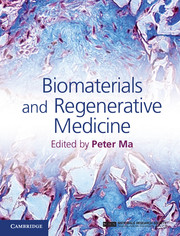Book contents
- Frontmatter
- Contents
- List of contributors
- Preface
- Part I Introduction to stem cells and regenerative medicine
- Part II Porous scaffolds for regenerative medicine
- 7 Nanofibrous polymer scaffolds with designed pore structure for regeneration
- 8 Electrospun micro/nanofibrous scaffolds
- 9 Biological scaffolds for regenerative medicine
- 10 Bioceramic scaffolds
- 11 Collagen-based tissue repair composite
- 12 Polymer/ceramic composite scaffolds for tissue regeneration
- 13 Computer-aided tissue engineering for modeling and fabrication of three-dimensional tissue scaffolds
- Part III Hydrogel scaffolds for regenerative medicine
- Part IV Biological factor delivery
- Part V Animal models and clinical applications
- Index
- References
11 - Collagen-based tissue repair composite
from Part II - Porous scaffolds for regenerative medicine
Published online by Cambridge University Press: 05 February 2015
- Frontmatter
- Contents
- List of contributors
- Preface
- Part I Introduction to stem cells and regenerative medicine
- Part II Porous scaffolds for regenerative medicine
- 7 Nanofibrous polymer scaffolds with designed pore structure for regeneration
- 8 Electrospun micro/nanofibrous scaffolds
- 9 Biological scaffolds for regenerative medicine
- 10 Bioceramic scaffolds
- 11 Collagen-based tissue repair composite
- 12 Polymer/ceramic composite scaffolds for tissue regeneration
- 13 Computer-aided tissue engineering for modeling and fabrication of three-dimensional tissue scaffolds
- Part III Hydrogel scaffolds for regenerative medicine
- Part IV Biological factor delivery
- Part V Animal models and clinical applications
- Index
- References
Summary
Introduction
The most abundant proteins in the extracellular matrix are members of the collagen family. Collagen is composed largely of the amino acids glycine, proline, and hydroxyproline, which are often present as Gly–X–Y repeats (where X and Y are either proline or hydroxyproline). Tropocollagen is the subunit of collagen fibrils formed of three polypeptide strands (each offset by one amino acid), approximately 300 nm long and 1.5 nm in diameter. Each of the three parallel polypeptide strands is in a left-handed helical polyproline II-type coil with three residues to form a right-handed triple helix. The tropocollagen units assemble in a parallel, quarter-staggered arrangement. There is a 40-nm gap, also called the “hole zone,” between the ends of each of these units, with 27 nm of overlap between adjacent units. The chemistry underlying the formation of these tissues is all quite similar; the fundamental differences depend on their hierarchical fibrillar architectures. More than 20 human collagens have been reported, many of which display a 67-nm periodicity, due to the axial packing of the individual collagen molecules [1, 2].
Collagens constitute an important family of proteins in the vertebrate body and serve as extracellular matrix molecules for many soft and hard connective tissues, including cornea, skin, tendon, cartilage, and bone [1, 3]. Collogen provides cellular recognition for regulating cell attachment and functions. Collagen favors cell adhesion that is normally found in joint tissues and those exogenous cells embedded in a collagen delivery device. Almost all of the connective tissues with collagen fibrils as the basic building blocks have remarkably similar chemistry at the macromolecular and fibrillar levels of structure. However, differentiation in the hierarchical structure takes place as these fibrils are arranged in the specific architecture required for the construction of special tissues each with unique functions, which is generally considered the function of other, non-collagen, molecules.
- Type
- Chapter
- Information
- Biomaterials and Regenerative Medicine , pp. 183 - 202Publisher: Cambridge University PressPrint publication year: 2014



